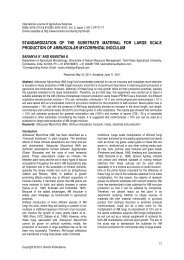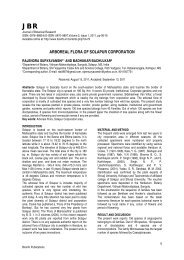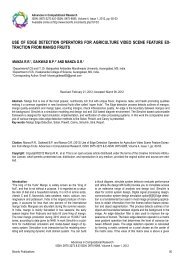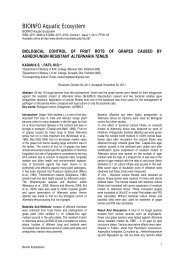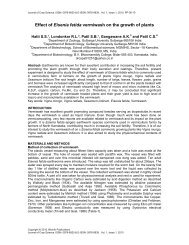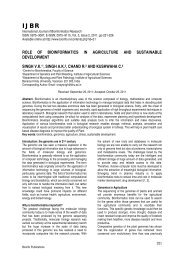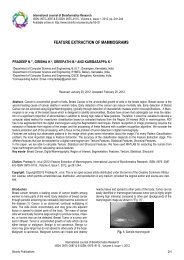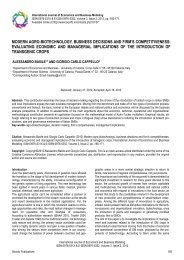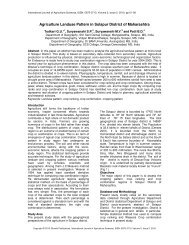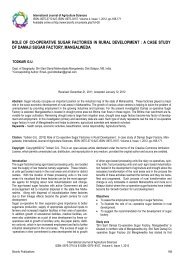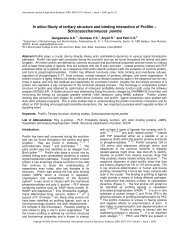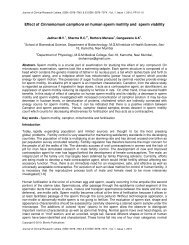Trichosanthes anguina L. is variety of Trichosanthese cucumerina L ...
Trichosanthes anguina L. is variety of Trichosanthese cucumerina L ...
Trichosanthes anguina L. is variety of Trichosanthese cucumerina L ...
You also want an ePaper? Increase the reach of your titles
YUMPU automatically turns print PDFs into web optimized ePapers that Google loves.
International Journal <strong>of</strong> Molecular Biology<br />
ISSN: 0976–0482 & E-ISSN: 0976–0490, Vol. 1, Issue 2, 2010, PP-01-14<br />
<strong>Trichosanthes</strong> <strong>anguina</strong> L. <strong>is</strong> <strong>variety</strong> <strong>of</strong> <strong>Trichosanthes</strong>e<br />
<strong>cucumerina</strong> L.- evidence based on molecular phylogenetic<br />
analys<strong>is</strong> <strong>of</strong> internal transcribed spacer (ITS) sequences <strong>of</strong><br />
nuclear ribosomal DNA<br />
Ajmal Ali M.* and Fahad M. A. Al-Hemaid<br />
*Department <strong>of</strong> Botany and Microbiology, College <strong>of</strong> Science, King Saud University, Riyadh, 11451, Saudi<br />
Arabia, ajmalpdrc@gmail.com<br />
Abstract- Phylogenetic relationship among some species <strong>of</strong> <strong>Trichosanthes</strong> L (Cucurbitaceae) was assessed<br />
using internal transcribed spacer (ITS) sequences <strong>of</strong> nuclear ribosomal DNA to infer the taxonomic status <strong>of</strong><br />
<strong>Trichosanthes</strong> <strong>anguina</strong>. The parsimony analys<strong>is</strong> <strong>of</strong> the entire ITS region resulted in 85 maximally<br />
parsimonious trees (MPTs) with a total length <strong>of</strong> 100 steps, a cons<strong>is</strong>tency index (CI) <strong>of</strong> 0.8800 (0. 8378<br />
excluding uninformative characters), a homoplasy index (HI) <strong>of</strong> 0.1200 (0. 1622 excluding uninformative<br />
characters), rescaled cons<strong>is</strong>tency index (RC) <strong>of</strong> 0.7733 and a retention index (RI) <strong>of</strong> 0.8788. Our findings<br />
support the recognition <strong>of</strong> T. <strong>cucumerina</strong> var. <strong>anguina</strong> (L.) Haines as a <strong>variety</strong> <strong>of</strong> T. <strong>cucumerina</strong>.<br />
Keywords: <strong>Trichosanthes</strong> <strong>anguina</strong>, <strong>Trichosanthes</strong>e <strong>cucumerina</strong>, Cucurbitaceae, ITS, nrDNA<br />
Introduction<br />
Genus <strong>Trichosanthes</strong> L. <strong>of</strong> tribe Trichosantheae,<br />
subtribe Trichosanthinae, family Cucurbitaceae<br />
include c. 100 species [1-5]. Principally it <strong>is</strong> an<br />
Asiatic genus. The geographic d<strong>is</strong>tribution <strong>of</strong> the<br />
genus indicates either an Indo-Malayan or<br />
Chinese Centre <strong>of</strong> origin [6]. Tichosanthes<br />
<strong>anguina</strong> (snake gourd or serpent gourd) <strong>is</strong> an<br />
usual cucurbits with long, white spackled fruits<br />
that actually in morphology resembles with snake<br />
and <strong>is</strong> widely grown as a vegetable in India and<br />
in the Orient. Roots and seeds are used to expel<br />
worms and to treat diarrhea and syphil<strong>is</strong> [7-8].<br />
Haines, 1921-1924 [9] recognized T. <strong>cucumerina</strong><br />
L. var. <strong>cucumerina</strong> (L) Haines as a wild variant<br />
with short fruits and T. <strong>cucumerina</strong> var. <strong>anguina</strong><br />
(L.) Haines as cultivated variant with elongated,<br />
snake-like fruits. Jeffrey, 1980 [6] also followed<br />
Haines, 1921-1924 [9] treatment <strong>of</strong> T. <strong>anguina</strong> as<br />
a <strong>variety</strong> <strong>of</strong> T. <strong>cucumerina</strong>. Chakravarty, 1982<br />
[10], however, treated these two varieties as two<br />
different species. Th<strong>is</strong> treatment has been<br />
followed in most <strong>of</strong> the Indian floras, monographs<br />
and research paper publ<strong>is</strong>hed so far. A perusal <strong>of</strong><br />
literature reveals that taxonomic status <strong>of</strong> T.<br />
<strong>anguina</strong> <strong>is</strong> controversial [11-17]. Hence, th<strong>is</strong><br />
study was undertaken to compare sequences <strong>of</strong><br />
the internal transcribed spacer regions <strong>of</strong> nrDNA<br />
in some species <strong>of</strong> <strong>Trichosanthes</strong> in order to infer<br />
taxonomic status <strong>of</strong> T. <strong>anguina</strong>.<br />
Materials and Methods<br />
Present study sampled 10 accessions <strong>of</strong><br />
<strong>Trichosanthes</strong> (ingroup) and Luffa (outgroup)<br />
from the geographical origin <strong>of</strong> Bihar, West<br />
Bengal and Sikkim (India) and South Korea.<br />
Voucher specimens are deposited at the BHAG<br />
(Herbarium, University Department <strong>of</strong> Botany,<br />
Tilka Manjhi Bhagalpur University, Bhagalpur,<br />
Bihar, India) and KRIB (Herbarium, Korea<br />
Research Institute <strong>of</strong> Bioscience and<br />
Biotechnology, Daejeon, South Korea). Sources<br />
<strong>of</strong> plant material used in th<strong>is</strong> study, along with<br />
voucher information and GenBank accession<br />
numbers, are l<strong>is</strong>ted in the Table 1. Based on<br />
chloroplast DNA sequences [17] and pollen<br />
morphology [18] a close relationship between<br />
tribe Trichosantheae and Luffeae have been<br />
suggested to which the genus <strong>Trichosanthes</strong> and<br />
Luffa belong. Therefore, the sequences <strong>of</strong> Luffa<br />
were used as outgroup. Total DNA was extracted<br />
using the DNeasy Plant Mini Kit (QIAGEN,<br />
Amsterdam, Netherlands). ITS sequences <strong>of</strong><br />
nuclear ribosomal DNA were amplified using<br />
primers ITS1 (Forward 5’-<br />
GTCCACTGAACCTTATCATTTAG-3’) and ITS4<br />
(Reverse 5’-TCCTCCGCTTATTGATATGC-3’)<br />
[19] via the polymerase chain reaction (PCR)<br />
using the AccuPower HF PCR PreMix (Bioneer,<br />
Daejeon, South Korea) in 20 µL volumes<br />
containing 2 µL <strong>of</strong> 10X buffer, 300 µM dNTPs, 1<br />
µL <strong>of</strong> a 10 pM solution <strong>of</strong> each primer, 1 unit <strong>of</strong><br />
HF DNA polymerase. The initial denaturation at<br />
94°C for 5 min, and followed by 40 cycles <strong>of</strong><br />
94°C for 1 min, 49°C for 1 min, and 72°C for 1<br />
min, with a final extension step <strong>of</strong> 72°C for 5 min.<br />
The PCR products were ligated into the pT7Blue<br />
cloning vector using Perfectly Blunt Cloning Kit<br />
(Novagen, Inc.) according to the manufacturer’s<br />
instructions. Resulting recombinant plasmids<br />
were used to transform competent cells included<br />
in the kit. The transformation mix was incubated<br />
in 250 µl SOC medium for 1hour at 37°C on a<br />
rotary shaker, then plated on LB agar with 50<br />
µg/mL ampicillin. Colonies were randomly<br />
selected and were put into PCR buffer. The PCR<br />
products were purified with the SolGent PCR<br />
Purification Kit-Ultra (SolGent, Daejeon, South<br />
Korea) prior to sequencing. The purified<br />
fragments were directly sequenced using dye<br />
terminator chem<strong>is</strong>try following the manufacturer’s<br />
protocol. Cycle sequencing was conducted using<br />
same primers used in amplification and BigDye<br />
vers. 3 reagents and an ABI PRISM 3730XL DNA<br />
Copyright © 2010, Bioinfo Publications<br />
International Journal <strong>of</strong> Molecular Biology, ISSN: 0976–0482 & E-ISSN: 0976–0490, Vol. 1, Issue 2, 2010
2<br />
<strong>Trichosanthes</strong> <strong>anguina</strong> L. <strong>is</strong> <strong>variety</strong> <strong>of</strong> <strong>Trichosanthes</strong>e <strong>cucumerina</strong> L.<br />
Analyzer (Perkin-Elmer, Applied Biosystems) by<br />
following the manufacturer’s instructions. Cycling<br />
conditions included an initial denaturing set at<br />
94°C for 5 min., followed by 30 cycles <strong>of</strong> 96°C for<br />
10 sec., 50°C for 5 sec., and 60°C for 4 minutes.<br />
Each sample was sequenced in the sense and<br />
ant<strong>is</strong>ense direction. The sequences were<br />
analyzed with ABI Sequence Analys<strong>is</strong> and ABI<br />
Sequence Navigator s<strong>of</strong>tware<br />
(Perkin-<br />
Elmer/Applied Biosystems). Nucleotide<br />
sequences <strong>of</strong> both DNA strands were obtained<br />
and compared to ensure accuracy. Initially the<br />
sequence alignments were performed using<br />
ClustalX version 1.81 [20] with gap opening<br />
penalty = 10 and gap extension penalty = 3.0.<br />
Sequence alignments were subsequently<br />
adjusted manually using BioEdit [21] and<br />
SeaView [22]. Insertion-deletions (Indels) were<br />
scored as single characters when we had<br />
confidence in positional homology (Annexure).<br />
The boundaries between the ITS1, 5.8S, and<br />
ITS2 were determined by compar<strong>is</strong>ons with<br />
earlier publ<strong>is</strong>hed sequences available at National<br />
Center for Biotechnology Information (NCBI)<br />
GenBank (www.ncbi.nlm.nih.gov). Gaps were<br />
treated as m<strong>is</strong>sing data in phylogenetic analyses.<br />
All sequences generated in the present study<br />
were deposited in GenBank and GenBank<br />
accession number included in Table 1.<br />
Parsimony analyses were performed with PAUP*<br />
4.0b10 [23]. Heur<strong>is</strong>tic searches were conducted<br />
using 10,000 random addition sequence<br />
replicates, holding 10 trees at each step, and with<br />
tree-b<strong>is</strong>ection-reconnection (TBR) branch<br />
swapping, characters equally weighted, and gaps<br />
treated as m<strong>is</strong>sing data. Support for internal<br />
nodes was assessed using bootstrap analys<strong>is</strong><br />
[24] <strong>of</strong> 1000 replicates with 100 random additions<br />
per replicate and holding 10 trees at each step.<br />
Phylogenetic and molecular evolutionary<br />
analyses (evolutionary divergence between<br />
sequences, the number <strong>of</strong> base substitutions per<br />
site from averaging evolutionary divergence over<br />
all sequence pairs, homogeneity test <strong>of</strong><br />
substitution patterns between sequences, base<br />
composition bias difference between sequences,<br />
maximum composite likelihood estimate <strong>of</strong> the<br />
pattern <strong>of</strong> nucleotide substitution, codon-based<br />
test <strong>of</strong> neutrality for analys<strong>is</strong> between sequences,<br />
and F<strong>is</strong>her's exact test <strong>of</strong> neutrality for sequence<br />
pairs) were conducted using MEGA version 4<br />
[25-28]. The result was verified with BioNJ and<br />
Parsimony analys<strong>is</strong> (using SeaView) and<br />
Baseyan analys<strong>is</strong> (Mr Bayes). For Bayesian<br />
analys<strong>is</strong>, the best-fit model <strong>of</strong> nucleotide<br />
evolution was found using jModelTest v1.0.1 [29].<br />
Bayesian posterior probabilities for the clades<br />
were obtained using Metropol<strong>is</strong>-coupled Markov<br />
chain Monte Carlo analys<strong>is</strong> as implemented in<br />
MrBayes. Two simultaneous independent runs<br />
with four Markov chains were done for 5 million<br />
generations, and trees were sampled every 100th<br />
generation, resulting in 50,000 trees. The first<br />
10,000 trees were considered as the burn-in<br />
phase and d<strong>is</strong>carded.<br />
Results<br />
Sequence Character<strong>is</strong>tics- The combined<br />
length <strong>of</strong> the entire ITS region (ITS1, 5.8S and<br />
ITS2) from taxa sampled in the present study<br />
ranged from 608-616 bp. The length <strong>of</strong> ITS1<br />
region and %GC ranged from 191-201 bp and<br />
61-62% respectively, the 5.8S gene was 163 bp,<br />
the length <strong>of</strong> ITS2 region and %GC ranged from<br />
235-260 bp and 65-67% respectively (Table 2).<br />
Data matrix has a total number <strong>of</strong> 632 characters<br />
<strong>of</strong> which 554 characters are constant, 25<br />
characters are variable but parsimonyuninformative<br />
and 55 characters are parsimonyinformative.<br />
Insertions and deletions (indels)<br />
were necessary to align the sequences. Indels<br />
were ranged from 1 to 11 bp.<br />
Phylogenetic analyses- The parsimony analys<strong>is</strong><br />
(using PAUP) <strong>of</strong> the entire ITS region resulted in<br />
85 maximally parsimonious trees (MPTs) with a<br />
total length <strong>of</strong> 100 steps, a cons<strong>is</strong>tency index (CI)<br />
<strong>of</strong> 0.88 (0. 8378 excluding uninformative<br />
characters), a homoplasy index (HI) <strong>of</strong> 0.12 (0.<br />
1622 excluding uninformative characters),<br />
rescaled cons<strong>is</strong>tency index (RC) <strong>of</strong> 0.7733 and a<br />
retention index (RI) <strong>of</strong> 0.8788. The bootstrap<br />
values above the line in bootstrap strict<br />
consensus tree (Fig. 1) show the relative support<br />
<strong>of</strong> each clade. The number <strong>of</strong> base substitutions<br />
per site from analys<strong>is</strong> between sequences<br />
(evolutionary divergence) <strong>is</strong> shown in Table 3.<br />
The number <strong>of</strong> base substitutions per site from<br />
averaging evolutionary divergence over all<br />
sequence pairs was found 0.048. Homogeneity<br />
test <strong>of</strong> substitution patterns between sequences:<br />
The probability <strong>of</strong> rejecting the null hypothes<strong>is</strong><br />
that sequences have evolved with the same<br />
pattern <strong>of</strong> substitution, as judged from the extent<br />
<strong>of</strong> differences in base composition biases<br />
between sequences. A Monte Carlo test (1000<br />
replicates) was used to estimate the P-values,<br />
which are shown in diagonal in the Table 4. Pvalues<br />
smaller than 0.05 are considered<br />
significant. The estimates <strong>of</strong> the d<strong>is</strong>parity index<br />
per site are shown for each sequence pair above<br />
the diagonal.<br />
Base composition bias difference between<br />
sequences: The difference in base composition<br />
bias per site <strong>is</strong> shown in Table 5. Even when the<br />
substitution patterns are homogeneous among<br />
lineages, the compositional d<strong>is</strong>tance correlates<br />
with the number <strong>of</strong> differences between<br />
sequences.<br />
Maximum composite likelihood estimate <strong>of</strong> the<br />
pattern <strong>of</strong> nucleotide substitution: Each entry<br />
shows the probability <strong>of</strong> substitution from one<br />
International Journal <strong>of</strong> Molecular Biology, ISSN: 0976–0482 & E-ISSN: 0976–0490, Vol. 1, Issue 2, 2010
ase (row) to another base (column)<br />
instantaneously. Rates <strong>of</strong> different transitional<br />
substitutions are shown in bold and those <strong>of</strong><br />
transversional substitutions are shown in italics.<br />
The nucleotide frequencies are 0.186 (A), 0.189<br />
(T/U), 0.353 (C), and 0.272 (G). The<br />
transition/transversion rate ratios are k1 = 2.313<br />
(purines) and k2 = 7.672 (pyrimidines). The<br />
overall transition/transversion bias <strong>is</strong> R = 3.349<br />
(Table 6).<br />
Codon-based test <strong>of</strong> neutrality for analys<strong>is</strong><br />
between sequences: The probability <strong>of</strong> rejecting<br />
the null hypothes<strong>is</strong> <strong>of</strong> strict-neutrality (dN = dS)<br />
(Codon-based test <strong>of</strong> neutrality for analys<strong>is</strong><br />
between sequences) <strong>is</strong> shown in Table 7 (below<br />
diagonal). Values <strong>of</strong> P less than 0.05 are<br />
considered significant at the 5% level. The test<br />
stat<strong>is</strong>tic (synonymous substitutions dN -<br />
nonsynonymous substitutions dS) <strong>is</strong> shown above<br />
the diagonal.<br />
F<strong>is</strong>her's exact test <strong>of</strong> neutrality for sequence<br />
pairs: The probability (P) <strong>of</strong> rejecting the null<br />
hypothes<strong>is</strong> <strong>of</strong> strict-neutrality in favor <strong>of</strong> the<br />
alternative hypothes<strong>is</strong> <strong>of</strong> positive selection <strong>is</strong><br />
shown for each sequence pair (Table 8). P<br />
values smaller than 0.05 are considered<br />
significant at the 5% level.<br />
D<strong>is</strong>cussion<br />
All bootstrap strict consensus trees resulting from<br />
the analys<strong>is</strong> <strong>of</strong> ITS sequences <strong>of</strong> nrDNA resolves<br />
two major clades i.e (1) T. lepiniana-T.<br />
tricuspidata (100 bootstrap support) and (2) T.<br />
diocia-T. <strong>cucumerina</strong> (74% bootstrap support). T.<br />
kirilowii sampled from South Korea show<br />
polytomy at base with both the groups (Fig. 1),<br />
however clearly nested with T. lepiniana-T.<br />
tricuspidata group within NJ tree (Figs. 2-3). T.<br />
<strong>cucumerina</strong> var. <strong>anguina</strong> clade shows proximity<br />
(98 % bootstrap support) with T. <strong>cucumerina</strong><br />
(Fig.1). The close relationship <strong>of</strong> T. <strong>cucumerina</strong><br />
var. <strong>anguina</strong> was also found cons<strong>is</strong>tent with<br />
BioNJ tree (Figs. 4-5), Parsimony tree (Fig. 6)<br />
analysed using SeaView and in Baseyan<br />
phylogeny (Fig.7), but never with 100 % bs. In<br />
BioNJ and Parsimony tree, T. <strong>cucumerina</strong> var.<br />
<strong>anguina</strong> clade with T. <strong>cucumerina</strong> by 89% and<br />
74 % bootstrap support respectively. T.<br />
<strong>cucumerina</strong> shows close relationship with T.<br />
dioica (74 % bootrap support). Haines, 1921-<br />
1924 [9] recognized T. <strong>cucumerina</strong> L. as a wild<br />
variant with short fruits and T. <strong>cucumerina</strong> var.<br />
<strong>anguina</strong> (L.) Haines as cultivated variant with<br />
elongated, snake-like fruits. Jeffrey, 1980 [6] also<br />
followed Haines 1921-1924 [9] varietal concept <strong>of</strong><br />
T. <strong>anguina</strong> as a <strong>variety</strong> <strong>of</strong> T. <strong>cucumerina</strong>.<br />
However, these two varieties have been treated<br />
as two different species in Indian Flora,<br />
monographs and research paper publ<strong>is</strong>hed so far<br />
[10, 30-38]. T. <strong>cucumerina</strong> and T. <strong>cucumerina</strong><br />
Ajmal Ali M and Fahad MA Al-Hemaid<br />
var. <strong>anguina</strong> share several morphological<br />
characters like: Herbs annual; Stem: slender, 5-<br />
angled; Petioles: striate, pubescent; Leaves:<br />
broadly ovate to orbicular, reniform, cordate at<br />
base, deeply 5-7 lobed or angled, d<strong>is</strong>tantly<br />
glabrous above, pubesent or scabrid beneath;<br />
Tendrils: 2-3 fid; Plant monoecious; Flower:<br />
white, bracts entire; Male flowers: peduncles,<br />
flowers solitary; Male flower Pedicels: 0.5-2.0 cm.<br />
long, slender, minutely bracteate, male flower<br />
calyx-tube 2.5 - 3.0 cm. long; petals c. 8-9 x 3<br />
mm. white, oblong, 3-nerved, c. 2 mm. long;<br />
Female flower: peduncles 0.5 - 5.0 cm. long,<br />
flowers solitary; Seeds: thick, ovate-oblong,<br />
compressed, corrugated, finely rugulose,<br />
undulate, apex round or obscurely truncate, base<br />
attenuate. The diagnostic features <strong>of</strong> T.<br />
<strong>cucumerina</strong> var. <strong>anguina</strong> are: anthers ovoid;<br />
ovary narrowly fusiform; fruits very long up to 1.5<br />
meter, cylindrical, <strong>of</strong>ten tw<strong>is</strong>ted or coiled, surface<br />
smooth, <strong>of</strong>ten 7- 8 white stripes along the length.<br />
T. <strong>cucumerina</strong> var. <strong>anguina</strong> vary from T<br />
<strong>cucumerina</strong> in having the morphological features<br />
i.e., anther and ovary oblong; fruits: 5-6 x 3.5-4.0<br />
cm, ovoid, conical, 8-10-seeded, tapering at both<br />
ends with a long sharp beak, red when ripe. In<br />
the present study, T. <strong>cucumerina</strong> var. <strong>anguina</strong><br />
clade with T. <strong>cucumerina</strong> (98% bootstrap<br />
support). Under th<strong>is</strong> clade (branch length 0.009)<br />
T. <strong>cucumerina</strong> var. <strong>anguina</strong> (branch length 0.008)<br />
deeply nested with T. <strong>cucumerina</strong> (Fig. 2-3). The<br />
relationship was found cons<strong>is</strong>tent (Fig. 4-7) when<br />
the results were verified with Maximum<br />
Parsimony method (using SeaView), and<br />
Baseyan analys<strong>is</strong>. Thus, our findings strongly<br />
support the recognition <strong>of</strong> T. <strong>cucumerina</strong> var.<br />
<strong>anguina</strong> (L.) Haines as a <strong>variety</strong> <strong>of</strong> T.<br />
<strong>cucumerina</strong>.<br />
Acknowledgement<br />
The senior author (MAA) would like to<br />
acknowledge sincere thank to Pr<strong>of</strong>essor Arun K.<br />
Pandey, Department <strong>of</strong> Botany, Delhi University,<br />
Delhi, India who was responsible for career in<br />
plant systematics, through whom only it become<br />
possible to d<strong>is</strong>cover the joys <strong>of</strong> botanical field<br />
work and DNA sequence based molecular<br />
taxonomy - a passion that has continued to th<strong>is</strong><br />
day also. The senior author (MAA) also would<br />
like to acknowledge sincere thank to Dr Joongku<br />
Lee, International Biological Material Research<br />
Centre (IBMRC), Plant Diversity Research Centre<br />
(PDRC), Korea Research Institute <strong>of</strong> Bioscience<br />
and Biotechnology (KRIBB), Daejeon, South<br />
Korea. Th<strong>is</strong> study was partially supported by<br />
Post Doctoral Fellowship from International<br />
Biological Material Research Centre (IBMRC),<br />
Plant Diversity Research Centre (PDRC), Korea<br />
Research Institute <strong>of</strong> Bioscience and<br />
Biotechnology (KRIBB), Daejeon, South Korea to<br />
Dr. M. Ajmal Ali. The senior author also thanks to<br />
Dr. Soo Yong Kim, Department <strong>of</strong> Biology, Dalat<br />
Copyright © 2010, Bioinfo Publications<br />
International Journal <strong>of</strong> Molecular Biology, ISSN: 0976–0482 & E-ISSN: 0976–0490, Vol. 1, Issue 2, 2010<br />
3<br />
3
<strong>Trichosanthes</strong> <strong>anguina</strong> L. <strong>is</strong> <strong>variety</strong> <strong>of</strong> <strong>Trichosanthes</strong>e <strong>cucumerina</strong> L.<br />
University, Vietnam, for h<strong>is</strong> kind help during DNA<br />
sequencing. We are grateful to anonymous<br />
reviewers for constrictive comments.<br />
References<br />
[1] Huang L., Yang B., and Yue C. (1997) Acta<br />
Phytotax Sin, 35, 125–135.<br />
[2] Rugayah E. A. and De Wilde W.J.J.O.<br />
(1997) Blumea, 42, 471–482.<br />
[3] Rugayah E. A. and De Wilde W.J.J.O.<br />
(1999) Reinwardtia, 11, 227–280.<br />
[4] Jeffrey C. (2005) Bot Zhurn, 90, 332–335.<br />
[5] Schaefer H., Kocyan A., and Renner S. S.<br />
(2008) Systematic Botany, 33(2), 349–<br />
355.<br />
[6] Jeffrey C. (1980) Bot J Linn Soc, 233-277.<br />
[7] Kirtikar K. and Basu B.D. (1975) B<strong>is</strong>hen<br />
Singh Mahendra Pal Singh, Dehra Dun.<br />
[8] Ali M.A. and Pandey A. K. (2007) Plant<br />
Systematics Research Centre (TMBU)<br />
Publication, Bhagalpur, India.<br />
[9] Haines H.H. (1921-1924) Allard and Son<br />
and West Newman Ltd. London<br />
[10] Chakravarty H.L. (1982) Botanical Survey <strong>of</strong><br />
India, Calcutta, India.<br />
[11] Decker-Whitaker T. W. (1933) Bot Gaz 94,<br />
780-790.<br />
[12] Jobst J., King K. and Hemleben V. (1998)<br />
Mol Phylo Evol, 9, 204-219.<br />
[13] Shanta A. and Radhakr<strong>is</strong>haniah M. (2000)<br />
Phytomorphology, 50(1), 103-111.<br />
[14] Chung S.M., Deena S., Walters D. and<br />
Staub J.E. (2003) Can J Bot, 81, 814-<br />
832.<br />
[15] Decker-Walter D.S., Chung S. and Staub J.<br />
E. (2004) J Mol Evol, 58, 606-614.<br />
[16] Zhang L.B., Mark P.S., Alexander K. and<br />
Renner S. S. (2006) Mol Phylo Evol, 39,<br />
305–322.<br />
[17] Kocyan A., Zhang L.B., Schaefer H. and<br />
Renner S. S. (2007) Mol. Phylo. Evol.<br />
44, 553–577.<br />
[18] Pruesapan K. and Raymond V.D.H. (2005)<br />
Grana, 44, 75–90.<br />
[19] White T. J., Bruns T., Lee S. and Taylor J.<br />
(1990) San Diego, California: Academic<br />
Press, 315-322.<br />
[20] Thompson J.D., Gibson T.J., Plewniak F.,<br />
Jeanmougin F. and Higgins D. G. (1997)<br />
Nucl Acid Res, 24, 4876–4882.<br />
[21] Hall T. A. (1999) Nucl Acid Symp Ser, 41,<br />
95-98.<br />
[22] Gouy M., Guindon S. and Gascuel O.<br />
(2010) Mol Bio Evol, 27(2), 221-224.<br />
[23] Sw<strong>of</strong>ford D. L. (2002) PAUP: Sinauer,<br />
Sunderland, Massachusetts.<br />
[24] Felsenstein J. (1985) Evol, 39, 783-791.<br />
[25] Nei M. and Gojobori T. (1986) Mol Phylo<br />
Evol, 3, 418-426.<br />
[26] Kumar S. and Gadagkar S.R. (2001)<br />
Genetics, 158, 1321-1327.<br />
4<br />
[27] Tamura K., Nei M. and Kumar S. (2004)<br />
Proc Nat Acad Sci (USA), 101, 11030-<br />
11035.<br />
[28] Tamura K., Dudley J., Nei M. and Kumar S.<br />
(2007) Mol Bio Evol, 24, 1596-1599.<br />
[29] Posada D. (2008) Mol Biol Evol, 25, 1253–<br />
1256.<br />
[30] Mary J.C. and Hopkins C.Y. (1964) Can J<br />
Chem 42, 560-564.<br />
[31] Rangaswamy N.S. and Shivanna K.R.<br />
(1975) Ann Bot 39, 193-196.<br />
[32] Sardar A. K. and Mukherjee K.K. (1987<br />
Theor Appl Genet, 74, 171-172.<br />
[33] Pasha M.K. and Sen S.P. (1995) Biochem<br />
System and Eco, 23(4), 399-406.<br />
[34] Shanavas K.R., Elyas K.K. and Vasudevan<br />
D. M. (1995) Bio Plan, 37 (3), 417-422.<br />
[35] Chow L.P., Chou M.H., Ho C.Y., Chuang C.<br />
C., Pan F. M., Wu S. H, and Lin J. Y.<br />
(1999) Biochem J, 338, 211-219.<br />
[36] Ojiako O.A. and Igwe C. U. (2008) Pak J<br />
Nut 7(1), 85-89.<br />
[37] Rahman A.H.M.M., An<strong>is</strong>uzzaman M., Alam<br />
M. Z., Islam A. K. M. R. and Zaman A. T.<br />
M. N. (2006) Res J Agr Bio Sci, 2(6):<br />
299-302.<br />
[38] Rahman A.H.M.M., An<strong>is</strong>uzzaman M.,<br />
Ahmed F., Rafiul Islam A.K.M. and<br />
Naderuzzaman A.T.M. (2008) J App Sci<br />
Res, 4(5), 555-558.<br />
International Journal <strong>of</strong> Molecular Biology, ISSN: 0976–0482 & E-ISSN: 0976–0490, Vol. 1, Issue 2, 2010
Ajmal Ali M and Fahad MA Al-Hemaid<br />
Table 1- Plant accessions used for the molecular systematic study <strong>of</strong> <strong>Trichosanthes</strong><br />
Taxon Voucher Geographic GenBank<br />
origin<br />
Accession No.<br />
Luffa acutangula (L.) Roxb. M. Ajmal Ali and A. K. Pandey 1061 (BHAG) Bihar, India GQ183044<br />
L. cylindrica (L.) M. Roem M. Ajmal Ali and A. K. Pandey 1089 (BHAG) Bihar, India GQ183045<br />
<strong>Trichosanthes</strong> <strong>cucumerina</strong> L. M. Ajmal Ali and A. K. Pandey 1113 (BHAG) Bihar, India GQ240883<br />
T. <strong>cucumerina</strong> L. Dako and Blattner s.n. Gudja, Ghana AM981174<br />
T. <strong>cucumerina</strong> var. <strong>anguina</strong> (L.) Haines M. Ajmal Ali and A. K. Pandey 1112 (BHAG) Bihar, India GQ240882<br />
T. dioica Roxb. M. Ajmal Ali and A. K. Pandey 1022 (BHAG) Bihar, India GQ240881<br />
T. kirilowii Maxim. M. Ajmal Ali and Joongku Lee 2076 (KRIBB) Kwang Ju, Korea GQ240884<br />
T. lepiniana (Naudin) Cogn. M. Ajmal Ali and A. K. Pandey 20052 (BHAG) West Bengal, GQ183049<br />
T. tricuspidata Lour. M. Ajmal Ali and A. K. Pandey 2075 (BHAG) Sikkim, India GQ240880<br />
T. tricuspidata Lour. M. Ajmal Ali and A. K. Pandey 1060 (BHAG) Bihar, India GQ183050<br />
Taxon<br />
Table 2- Length and GC Contents <strong>of</strong> ITS1 and ITS2<br />
India<br />
ITS 1 ITS2<br />
Size (bp) %GC Size (bp) %GC<br />
Luffa acutangula 201 61 235 65<br />
L. cylindrica 201 61 258 65<br />
<strong>Trichosanthes</strong> <strong>cucumerina</strong> 1113 191 61 258 66<br />
T. <strong>cucumerina</strong> var. <strong>anguina</strong><br />
191 61 260 66<br />
T. <strong>cucumerina</strong> AM981174 191 61 258 66<br />
T. dioica 191 62 257 67<br />
T. kirilowii 193 61 246 67<br />
T. lepiniana 200 61 236 66<br />
T. tricuspidata 2075 199 61 249 65<br />
T. tricuspidata 1060 199 61 235 66<br />
Taxon<br />
<strong>Trichosanthes</strong> lepiniana<br />
Table 3- Evolutionary divergence between sequences <strong>of</strong> species <strong>of</strong> <strong>Trichosanthes</strong><br />
Luffa cylindrica 0.071<br />
<strong>Trichosanthes</strong> tricuspidata 2075 0.010 0.070<br />
<strong>Trichosanthes</strong> tricuspidata 1060 0.010 0.070 0.000<br />
Luffa acutangula 0.077 0.005 0.076 0.076<br />
<strong>Trichosanthes</strong> dioica 0.055 0.072 0.056 0.056 0.078<br />
<strong>Trichosanthes</strong> kirilowii 0.047 0.054 0.047 0.047 0.056 0.037<br />
<strong>Trichosanthes</strong> <strong>cucumerina</strong> var. <strong>anguina</strong> 0.057 0.070 0.057 0.057 0.076 0.030 0.039<br />
<strong>Trichosanthes</strong> <strong>cucumerina</strong> 0.049 0.060 0.049 0.049 0.066 0.028 0.030 0.009<br />
<strong>Trichosanthes</strong> <strong>cucumerina</strong> AM981174 0.049 0.060 0.049 0.049 0.066 0.028 0.030 0.009 0.000<br />
Copyright © 2010, Bioinfo Publications<br />
International Journal <strong>of</strong> Molecular Biology, ISSN: 0976–0482 & E-ISSN: 0976–0490, Vol. 1, Issue 2, 2010<br />
5<br />
5
6<br />
<strong>Trichosanthes</strong> <strong>anguina</strong> L. <strong>is</strong> <strong>variety</strong> <strong>of</strong> <strong>Trichosanthes</strong>e <strong>cucumerina</strong> L.<br />
Table 4- Test <strong>of</strong> the homogeneity <strong>of</strong> substitution patterns between sequences <strong>of</strong> <strong>Trichosanthes</strong><br />
Taxon<br />
<strong>Trichosanthes</strong> lepiniana 0.000 0.005 0.005 0.028 0.000 0.000 0.000 0.000<br />
Luffa cylindrica 1.000 0.000 0.000 0.007 0.000 0.000 0.000 0.000<br />
<strong>Trichosanthes</strong> tricuspidata 2075 0.268 1.000 0.000 0.003 0.000 0.000 0.000 0.000<br />
<strong>Trichosanthes</strong> tricuspidata 1060 0.247 1.000 1.000 0.003 0.000 0.000 0.000 0.000<br />
Luffa acutangula 0.243 0.116 0.398 0.361 0.022 0.031 0.000 0.000<br />
<strong>Trichosanthes</strong> dioica 1.000 1.000 1.000 1.000 0.278 0.000 0.000 0.000<br />
<strong>Trichosanthes</strong> kirilowii 1.000 1.000 1.000 1.000 0.214 1.000 0.000 0.000<br />
<strong>Trichosanthes</strong> <strong>cucumerina</strong> var.<br />
<strong>anguina</strong> 1.000 1.000 1.000 1.000 1.000 1.000 1.000 0.000<br />
<strong>Trichosanthes</strong> <strong>cucumerina</strong> 1.000 1.000 1.000 1.000 1.000 1.000 1.000 1.000<br />
<strong>Trichosanthes</strong> <strong>cucumerina</strong> AM981174 1.000 1.000 1.000 1.000 1.000 1.000 1.000 1.000 1.000<br />
Taxon<br />
<strong>Trichosanthes</strong> lepiniana<br />
Table 5- Base composition bias difference between sequences <strong>of</strong> <strong>Trichosanthes</strong><br />
Luffa cylindrica 0.043<br />
<strong>Trichosanthes</strong> tricuspidata 2075 0.016 0.036<br />
<strong>Trichosanthes</strong> tricuspidata 1060 0.016 0.036 0.000<br />
Luffa acutangula 0.098 0.012 0.074 0.074<br />
<strong>Trichosanthes</strong> dioica 0.021 0.043 0.033 0.033 0.095<br />
<strong>Trichosanthes</strong> kirilowii 0.016 0.040 0.007 0.007 0.084 0.012<br />
<strong>Trichosanthes</strong> <strong>cucumerina</strong> var. <strong>anguina</strong> 0.016 0.022 0.003 0.003 0.057 0.019 0.003<br />
<strong>Trichosanthes</strong> <strong>cucumerina</strong> 0.016 0.022 0.003 0.003 0.057 0.019 0.003 0.000<br />
<strong>Trichosanthes</strong> <strong>cucumerina</strong> AM981174 0.016 0.022 0.003 0.003 0.057 0.019 0.003 0.000 0.000<br />
Table 6- Maximum composite likelihood estimate <strong>of</strong> the pattern <strong>of</strong> nucleotide substitution <strong>of</strong> <strong>Trichosanthes</strong><br />
A T C G<br />
A - 2.62 4.89 8.71<br />
T 2.57 - 37.53 3.77<br />
C 2.57 20.1 - 3.77<br />
G 5.95 2.62 4.89 -<br />
International Journal <strong>of</strong> Molecular Biology, ISSN: 0976–0482 & E-ISSN: 0976–0490, Vol. 1, Issue 2, 2010
Ajmal Ali M and Fahad MA Al-Hemaid<br />
Table 7- Codon-based test <strong>of</strong> neutrality for analys<strong>is</strong> between sequences <strong>of</strong> <strong>Trichosanthes</strong><br />
Taxon<br />
-<br />
- -<br />
<strong>Trichosanthes</strong> lepiniana 0.146 0.384 0.384 0.257 -0.515 0.061 -0.544 0.623 0.623<br />
-<br />
-<br />
- -<br />
Luffa cylindrica 0.884 -0.294 0.294 1.001 -1.055 0.762 -1.489 1.727 1.727<br />
-<br />
-<br />
- -<br />
<strong>Trichosanthes</strong> tricuspidata 2075 0.702 0.769 0.000 0.187 -0.862 0.463 -0.863 0.953 0.953<br />
-<br />
-<br />
- -<br />
<strong>Trichosanthes</strong> tricuspidata 1060 0.702 0.769 1.000 0.187 -0.862 0.463 -0.863 0.953 0.953<br />
-<br />
- -<br />
Luffa acutangula 0.798 0.319 0.852 0.852 -0.938 0.642 -1.363 1.591 1.591<br />
-<br />
- -<br />
<strong>Trichosanthes</strong> dioica 0.607 0.293 0.390 0.390 0.350<br />
0.439 -0.069 0.252 0.252<br />
- -<br />
<strong>Trichosanthes</strong> kirilowii<br />
<strong>Trichosanthes</strong> <strong>cucumerina</strong> var.<br />
0.951 0.447 0.644 0.644 0.522 0.661 -0.330 0.596 0.596<br />
<strong>anguina</strong> 0.587 0.139 0.390 0.390 0.175 0.945 0.742 0.546 0.546<br />
<strong>Trichosanthes</strong> <strong>cucumerina</strong> 0.535 0.087 0.342 0.342 0.114 0.802 0.552 0.586 0.000<br />
<strong>Trichosanthes</strong> <strong>cucumerina</strong> AM981174 0.535 0.087 0.342 0.342 0.114 0.802 0.552 0.586 1.000<br />
<strong>Trichosanthes</strong> lepiniana<br />
Taxon<br />
Table 8- F<strong>is</strong>her's exact test <strong>of</strong> neutrality for sequence pairs <strong>of</strong> <strong>Trichosanthes</strong><br />
Luffa cylindrica 0.504<br />
<strong>Trichosanthes</strong> tricuspidata 2075 0.592 1.000<br />
<strong>Trichosanthes</strong> tricuspidata 1060 0.592 1.000 1.000<br />
Luffa acutangula 0.550 0.727 1.000 1.000<br />
<strong>Trichosanthes</strong> dioica 1.000 1.000 1.000 1.000 1.000<br />
<strong>Trichosanthes</strong> kirilowii 1.000 1.000 1.000 1.000 1.000 1.000<br />
<strong>Trichosanthes</strong> <strong>cucumerina</strong> var. <strong>anguina</strong> 1.000 1.000 1.000 1.000 1.000 1.000 1.000<br />
<strong>Trichosanthes</strong> <strong>cucumerina</strong> 1.000 1.000 1.000 1.000 1.000 1.000 1.000 0.571<br />
<strong>Trichosanthes</strong> <strong>cucumerina</strong> AM981174 1.000 1.000 1.000 1.000 1.000 1.000 1.000 0.571 1.000<br />
Copyright © 2010, Bioinfo Publications<br />
International Journal <strong>of</strong> Molecular Biology, ISSN: 0976–0482 & E-ISSN: 0976–0490, Vol. 1, Issue 2, 2010<br />
7<br />
7
8<br />
100<br />
100<br />
74<br />
<strong>Trichosanthes</strong> <strong>anguina</strong> L. <strong>is</strong> <strong>variety</strong> <strong>of</strong> <strong>Trichosanthes</strong>e <strong>cucumerina</strong> L.<br />
98<br />
98<br />
Luffa cylindrica<br />
Luffa acutangula<br />
<strong>Trichosanthes</strong> kirilowii<br />
<strong>Trichosanthes</strong> lepiniana<br />
<strong>Trichosanthes</strong> tricuspidata 2075<br />
<strong>Trichosanthes</strong> tricuspidata 1060<br />
<strong>Trichosanthes</strong> dioica<br />
<strong>Trichosanthes</strong> <strong>cucumerina</strong> var. <strong>anguina</strong><br />
<strong>Trichosanthes</strong> <strong>cucumerina</strong> 1113<br />
<strong>Trichosanthes</strong> <strong>cucumerina</strong> AM981174<br />
Fig. 1- The strict consensus tree <strong>of</strong> 85 maximally parsimonious trees <strong>of</strong> <strong>Trichosanthes</strong> based on the ITS<br />
sequences <strong>of</strong> nuclear ribosomal DNA data set with gaps being treated as m<strong>is</strong>sing data (100 steps, a<br />
cons<strong>is</strong>tency index (CI) <strong>of</strong> 0.8800 (0. 8378 excluding uninformative characters), a homoplasy index (HI) <strong>of</strong><br />
0.1200 (0. 1622 excluding uninformative characters), rescaled cons<strong>is</strong>tency index (RC) <strong>of</strong> 0.7733 and a<br />
retention index (RI) <strong>of</strong> 0.8788. Bootstrap values greater than 50% in 1000 bootstrap replicates are shown<br />
above lines<br />
International Journal <strong>of</strong> Molecular Biology, ISSN: 0976–0482 & E-ISSN: 0976–0490, Vol. 1, Issue 2, 2010
NJ<br />
0.039<br />
0.003<br />
0.006<br />
0.023<br />
0.009<br />
0.014<br />
0.008<br />
0.015<br />
0.000<br />
0.012<br />
0.008<br />
0.004<br />
0.006<br />
Ajmal Ali M and Fahad MA Al-Hemaid<br />
Copyright © 2010, Bioinfo Publications<br />
International Journal <strong>of</strong> Molecular Biology, ISSN: 0976–0482 & E-ISSN: 0976–0490, Vol. 1, Issue 2, 2010<br />
0<br />
0<br />
0<br />
0<br />
Luffa cylindrica<br />
Luffa acutangula<br />
<strong>Trichosanthes</strong> kirilowii<br />
<strong>Trichosanthes</strong> lepiniana<br />
<strong>Trichosanthes</strong> tricuspidata 2075<br />
<strong>Trichosanthes</strong> tricuspidata 1060<br />
<strong>Trichosanthes</strong> dioica<br />
<strong>Trichosanthes</strong> <strong>cucumerina</strong> var. <strong>anguina</strong><br />
<strong>Trichosanthes</strong> <strong>cucumerina</strong> 1113<br />
<strong>Trichosanthes</strong> <strong>cucumerina</strong> AM981174<br />
Fig. 2- The neighbor joining tree (rectangular cladogram) <strong>of</strong> <strong>Trichosanthes</strong> based on the ITS sequences <strong>of</strong><br />
nuclear ribosomal DNA data set. Nnmbers above the line indicates branch length.<br />
9<br />
9
10<br />
<strong>Trichosanthes</strong> <strong>anguina</strong> L. <strong>is</strong> <strong>variety</strong> <strong>of</strong> <strong>Trichosanthes</strong>e <strong>cucumerina</strong> L.<br />
0.005 substitution/site<br />
<strong>Trichosanthes</strong> kirilowii<br />
<strong>Trichosanthes</strong> dioica<br />
Luffa cylindrica<br />
Luffa acutangula<br />
<strong>Trichosanthes</strong> lepiniana<br />
<strong>Trichosanthes</strong> tricuspidata 2075<br />
<strong>Trichosanthes</strong> tricuspidata 1060<br />
<strong>Trichosanthes</strong> <strong>cucumerina</strong> var. <strong>anguina</strong><br />
<strong>Trichosanthes</strong> <strong>cucumerina</strong> 1113<br />
<strong>Trichosanthes</strong> <strong>cucumerina</strong> AM981174<br />
Fig. 3- The NJ phylogram <strong>of</strong> <strong>Trichosanthes</strong> based on the ITS sequences <strong>of</strong> nuclear ribosomal DNA data set.<br />
The scale bar indicates relative length <strong>of</strong> the branch.<br />
International Journal <strong>of</strong> Molecular Biology, ISSN: 0976–0482 & E-ISSN: 0976–0490, Vol. 1, Issue 2, 2010
Ajmal Ali M and Fahad MA Al-Hemaid<br />
Fig. 4- BioNJ tree inferred from internal transcribed spacer region <strong>of</strong> nuclear ribosomal DNA. The tree<br />
constructed using SeaView after multiple alignment in MUSCLE. The number above the line indicates<br />
bootstrap support<br />
Copyright © 2010, Bioinfo Publications<br />
International Journal <strong>of</strong> Molecular Biology, ISSN: 0976–0482 & E-ISSN: 0976–0490, Vol. 1, Issue 2, 2010<br />
11<br />
11
<strong>Trichosanthes</strong> <strong>anguina</strong> L. <strong>is</strong> <strong>variety</strong> <strong>of</strong> <strong>Trichosanthes</strong>e <strong>cucumerina</strong> L.<br />
Fig. 5- BioNJ tree (phylogram ) inferred from internal transcribed spacer region <strong>of</strong> nuclear ribosomal DNA.<br />
The tree constructed using SeaView after multiple alignment in MUSCLE. The number above the line<br />
indicates bootstrap support<br />
12<br />
International Journal <strong>of</strong> Molecular Biology, ISSN: 0976–0482 & E-ISSN: 0976–0490, Vol. 1, Issue 2, 2010
Ajmal Ali M and Fahad MA Al-Hemaid<br />
Fig. 6- Bootstrap strict consensus tree based on internal transcribed spacer region <strong>of</strong> nuclear ribosomal<br />
DNA. The tree constructed using Maximum Parsimony method in SeaView after multiple alignment in<br />
MUSCLE. The number at nodes indicates bootstrap support in 100 bootstrap replicates<br />
Copyright © 2010, Bioinfo Publications<br />
International Journal <strong>of</strong> Molecular Biology, ISSN: 0976–0482 & E-ISSN: 0976–0490, Vol. 1, Issue 2, 2010<br />
13<br />
13
14<br />
0.01<br />
<strong>Trichosanthes</strong> <strong>anguina</strong> L. <strong>is</strong> <strong>variety</strong> <strong>of</strong> <strong>Trichosanthes</strong>e <strong>cucumerina</strong> L.<br />
96<br />
100<br />
100 Luffa acutangula<br />
Luffa cylindrica<br />
<strong>Trichosanthes</strong> lepiniana<br />
100<br />
86 <strong>Trichosanthes</strong> tricuspidata 2075<br />
<strong>Trichosanthes</strong> tricuspidata 1060<br />
<strong>Trichosanthes</strong> kirilowii<br />
<strong>Trichosanthes</strong> dioica<br />
<strong>Trichosanthes</strong> <strong>cucumerina</strong> var <strong>anguina</strong><br />
<strong>Trichosanthes</strong> <strong>cucumerina</strong><br />
<strong>Trichosanthes</strong> <strong>cucumerina</strong> AM981174<br />
Fig. 7- Bayesian phylogeny with bootstrap support based on analys<strong>is</strong> <strong>of</strong> ITS sequences <strong>of</strong> nrDNA.<br />
International Journal <strong>of</strong> Molecular Biology, ISSN: 0976–0482 & E-ISSN: 0976–0490, Vol. 1, Issue 2, 2010



